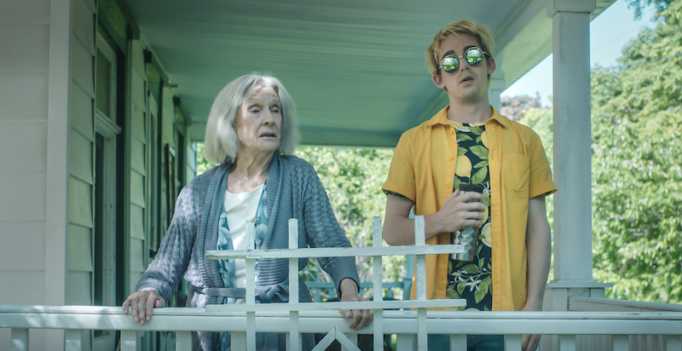At a time when drag has made its way into mainstream media (thanks, in no small part, to the Emmy winning reality television show Ru Paul’s Drag Race), Jump, Darling stands as a much-needed antidote to the commodification of an art form that was created by and for queer and trans people. It isn’t a bad thing that straight folks these days know what a death drop is, but at times it does feel as though drag has been removed from its original habitat and stripped of its ability to meaningfully challenge dominant ideas of gender, sexuality, and respectability.
Director Phil Connell’s Jump, Darling takes drag back to its roots. Russell (Thomas Duplessie) is a struggling actor-turned-fledgling drag queen. After screwing up his shot at a big city club called “Pecker’s” (clearly a homage to the famous Woody’s, a staple venue in Toronto’s drag scene), Russell crash lands at his grandmother’s house in Prince Edward County, in rural Ontario, and begins hanging out and performing at the local queer watering hole.
This is a film that takes its time, perhaps more time than is necessary, to establish its characters and premise. That said, a little patience pays off. Though it took a while for Jump, Darling to find its footing, once it really got rolling, I knew that I was watching something special.
At its heart, Jump, Darling is a film about intergenerational trauma, memory, and healing through art. Cloris Leachman (The Last Picture Show, Young Frankenstein, I Can Only Imagine) is perfection as Russell’s grandmother, hitting just the right note of humour and vulnerability. There is a careful, and sometimes almost awkward, tenderness in her on screen energy with Duplessie that works with the somewhat distant nature of their characters’ relationship. In the film, art and performance are not just about individual self expression. Instead, they become a means of traversing space and time. The editing and musical score come together in interesting ways that transport the viewer and characters across time and space, emphasizing the power of music to transcend the boundaries of the here and now. Similarly, it is drag that allows Russell to connect with his grandmother – and, by extension, himself.
The lip-sync numbers are depicted in long, intimate shots and incapsulate both the passion and raw emotion of Thomas Duplessie’s performance. The drag presented in Jump, Darling is not the plastic, hyper-commercialized variety that has seeped into mainstream popular culture. It is messy. It is sweaty. It is dirty. As someone who spent a lot of my early twenties watching this kind of drag on stages in both rural Canada and Toronto, it felt authentic. It also made me long for the physical queer spaces that I have not visited in more than a year, many of which will not survive the COVID-19 pandemic. It reminded me how special these places are – the gay bars, and the drag nights, and the queer pop-up parties – and how essential they are to queer community and expression.
Cloris Leachman passed away earlier this year. Though Jump, Darling will be remembered, rightfully, for Leachman’s stunning performance in one of the final roles of her long career, I hope it is also remembered on its own terms – as a beautiful, carefully crafted love letter to queer art. And, as a must-watch for anyone who loves the art of drag, regardless of their orientation.
**********
Do You Tweet? Follow These Tweeple:
Shannon Page: @ShannonEvePage




Be the first to comment